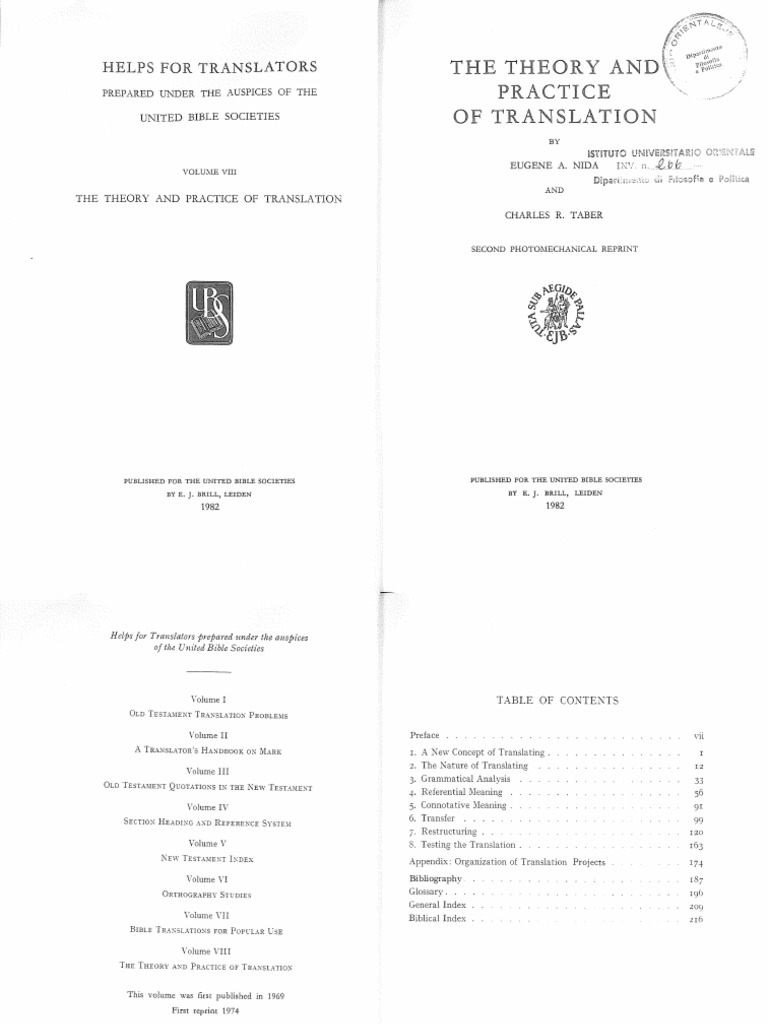
Any valid theory of translation must embrace these two aspects. To do this, a multidisciplinary approach to translation theory integrating these aspects in a plausible manner is needed. Further, a theory of translation is not possible without a reflection on the role of one of its core concepts: equivalence in translation. Evolution of Translation Theories & Practice Sonia Firdaus The Dialogue 279 Volume VII Number 3 any cost, then the theory of translation will be suitable to follow. In the past the goal of translation was to provide mere understanding of the intended texts. SOME THEORIES ON TRANSLATION (A Summary) Translation An operation performed on languages: a process of substituting a text in one language for a text in another. (Catford, 1965: 1) To translate is to change a text from one state or form to another, or to turn a text into. Of translation rather than to a comparative analysis of two languages. The study is set up on the basis of communication theory in general, and draws upon various linguistic theories and other language—related disciplines such as psycholinguistics, semiotics, etc. The basic suggestion posited is that translation should be viewed as a special. Text Analysis in Translation: Theory, Methodology and Didactic Application of a Model for Translation-Oriented Text Analysis. ISBN: Text Analysis in Translation has become a classic in Translation Studies. Based on a functional approach to translation and indebted to pragmatic text linguistics, it suggests a model for translation.
Philological Theories Of Translation Pdf
General Editors: Peter France and Stuart Gillespie
This groundbreaking five-volume history runs from the Middle Ages to the year 2000. It is a critical history, treating translations wherever appropriate as literary works in their own right, and reveals the vital part played by translators and translation in shaping the literary culture of the English-speaking world, both for writers and readers. It thus offers new and often challenging perspectives on the history of literature in English. As well as examining the translations and their wider impact, it explores the processes by which they came into being and were disseminated, and provides extensive bibliographical and biographical reference material.
In the period covered by Volume 2 comes a drive, unprecedented in its energy and scope, to bring foreign writing of all kinds into English. The humanist scholar depicted in Antonello's St Jerome, the jacket illustration, is one of the figures at work, and one of the most self-conscious and prolonged encounters that took place was with the Bible, a uniquely fraught and intimidating original. But early modern English translation often finds its setting within far busier scenes of worldly life - on the London stage, as a bid for patronage, for purposes polemical, political, hortatory, instructional, and as a way of making a living in the expanding book trade.
Translation became, as never before, a part of the English writer's career, and sometimes a whole career in itself. Translation was also fundamental in the evolution of the still unfixed English language and its still unfixed literary styles. Some translations of this period have themselves become landmarks in English literature and have exercised a profound and enduring influence on perceptions of their originals in the anglophone world; others less well-known are treated more comprehensively here than in any previous history. The entire phenomenon is documented in an extensive bibliography of literary translations of the period, the most comprehensive ever compiled. The work of our early modern translators, with all its energy, is not always scholarly or even always convincing. But after this era is over English translation never again feels quite so urgent or contentious.